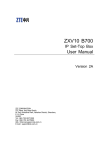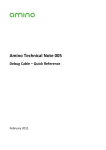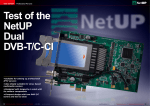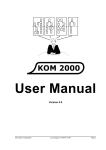Download NetUP IPTV Combine 4x & Amino AmiNET130M - TELE
Transcript
TEST REPORT IPTV Operator Software System – Part 1 NetUP IPTV Combine 4x & Amino AmiNET130M Professional software for IPTV operators Thomas Haring •After having discussed the streaming function of the NetUP IPTV Combine 4x in TELE-satellite issue 10-11/2010 it is now time to have a closer look at all the features required to create a user-friendly OSD (on-screen display) for customers and to help them use all IPTV functions on the one hand, as well as to assist operators in maintaining full control over what type of content is available to end users, and what price they have to pay. ■ The IPTV Combine 4x was the focus of an in-depth test report in TELE-satellite issue 10-11/2010. ■ IPTV Combine 4x from NetUP – the core of the IPTV network presented in this report. 26 TELE-satellite — Global Digital TV Magazine — 02-03/2011 — www.TELE-satellite.com 1 2 3 4 5 6 Middleware – interface between end user and IPTV network channels find their way into solution which takes care of a neat OSD system on the presenting IPTV content in IPTV receiver. Middleware is a software the channel list, it creates a user-friendly EPG (electronic program guide) and – last but by no means least – it packages all information into Basic configuration of the IPTV Combine 4x 1. The United Control Center is an integrated feature of the IPTV Combine 4x server and can be directly downloaded from there 2. All IPTV receivers in the network can be provided with software updates from the central firmware update server 3. Various OSD themes (skins) can be created, edited and saved on the IPTV server 4. IPTV operators can decide to have OSD texts translated into any required language 5. A web interface is available to launch, quit and adjust all IPTV Combine 4x services a visually pleasing way to customers of IPTV opera- Generally, there are two tors. It makes sure the right types of middleware that can 6. The IPTV Combine 4x boasts 1TB of internal hard disk capacity to store VOD and nVOD content www.TELE-satellite.com — 02-03/2011 — TELE-satellite — Global Digital TV Magazine 27 1 be used: The more simple version consists of the web server which creates and provides HTML pages and JavaScript applications, which in turn are made available to IPTV receivers which then display all corresponding information on the end users‘ screens. In such a system the middleware takes over the role of trol as well as marketing. Every time an IPTV network is set up to make money you need extended middleware, such as the IPTV Combine 4x from Russian company NetUP. The receiver component of the NetUP middleware is written in C++, runs directly on the IPTV receiver and therefore allows lag-free use of all features, even in there is the server end (IPTV Combine 4x Server) which provides all required information. And then there is the client end (IPTV receiver) which receives this information, processes all data and creates a graphic userinterface. As these two components need to work very closely with each other all of the time, middleware and 3 2 Main menu of the NetUP middleware 1. United Control Center main menu 2. Thanks to a DNS server all services within an IPTV network can be addressed by name. While IP addresses can be used as well, they are no prerequisite. 3. List of existing TV and radio channels in the middleware 4. Adding a new TV channel complete with logo and station details 4 web server, while the IPTV box at the client end acts as web browser. While this is a system that can be set up and implemented easily, it does not serve any commercial purpose, as IPTV operators have no billing option and no way of controlling access to content. The second middleware category is more complex, but at the same time more versatile and much more for useful as a business application. It is based on IPTV boxes that are not only capable of displaying received information, but can also communicate with the middleware so that they cannot only create a nice OSD for end users, but also assist in billing, content and cost con- connection with a high-definition on-screen display, which is an important aspect these days and – in particular – in future. Middleware Strictly speaking, the NetUP Combine 4x middleware consists of two distinct components: For one, IPTV box must be compatible with each other. If the NetUP IPTV Combine 4x is the middleware of choice operators can choose from a number of compatible IPTV boxes. For the purpose of this test report we have selected the AmiNET130M from Amino. All features and configurations of the NetUP IPTV 28 TELE-satellite — Global Digital TV Magazine — 02-03/2011 — www.TELE-satellite.com Combine 4x are partly controlled via a web interface which is used to launch, activate, deactivate and set up individual services such as streaming, middleware, VOD, etc. More detailed settings of the middleware, the billing system and the video-on-demand system are accessed through the socalled United Control Center. 5 5. Individual channels and their IP data within the IPTV network 6. Various packages with differing content 7. User account administration 6 7 We already dealt with the web interface in our first test report in TELE-satellite issue 10-11/2010, and now we take a closer look at the United Control Center. It is basically a Java application which – thanks to this universal programming language – can be run on different platforms such as MS Windows, Linux or Apple, where it is used to control the entire content management system. The United Control Center main menu is made up of four elements: billing, middleware, nVOD (near videoon-demand)/VOD and DRM (digital rights management). The last two elements, TVOD (TV-on-demand) and DRM are proprietary solutions of NetUP, which were not part of our test system and which therefore cannot be evaluated in this report. With the a simple middleware click icon on the NetUP United Control Center (UCC) opens up access to media groups, media content and media streams. All three to items add, bine are remove media intended or content. comWith media groups it is possible to group together different media content (such as TV channels, radio channels or video-on-demand content) into packages. This allows creating a starter package, for example, which includes only limited content, or an extended package with fullrange content. In order to grasp the underlying logics of the NetUP IPTV system we have to put ourselves in the role of an IPTV operator. This begins with starting to think and act like a commercial operation. As most of us come from terrestrial or satellite reception we are used to the fact that all content is always available to all users. Even if we‘re talking about subscription TV we simply obtain a smartcard and all of a sudden encrypted content is available on screen as well. IPTV is different in a fundamental way: Thanks to direct communication between end user and IPTV operator, complete with return channel, it would be a total waste of resources to send all content to all customers all of the time in the first place, only to then grant or restrict access (as is the case with terrestrial and satellite TV). Instead, IPTV operators create individual packages for a single customer or a certain group of customers. Let‘s take a hotel as an example: The hotel owner makes a certain range of basic TV and radio channels available to all guests, the price of which is included in the room rate. Therefore, we use the middleware to group together all required 30 TELE-satellite — Global Digital TV Magazine — 02-03/2011 — www.TELE-satellite.com TV and radio channels by letting the system know the corresponding IP addresses and ports – after we have configured them via the web interface of the streaming component of the IPTV Combine 4x. In order to simulate a realworld scenario we design a package with three HD channels, three SD channels as well as two radio channels from two different satellites. The IPTV Combine 4x is equipped with a total of four DVB/S2 tuners (see test report in TELE-satellite 10-11/2010) and so we are at liberty to select content from up to four different transponders or satellite positions. We then bundle these 8 8. Different rate plans can be activated and deactivated for each single customer 9 10 9. Setting up and editing rate plans 10. Customers are able to get access to individual channels at a set price 11. A currency converter can be used to display amounts in different currencies with the IPTV set-top box eight channels into a package labelled ‚Basic‘. Next, it is time to think about making money. To that end, we decide to create two additional packages, one with current movies, and the second with live sports coverage. The procedure is the same as for the ‚Basic‘ package, with configuring the individual TV channels using the web interface of the streaming server, before determining their IP addresses and ports using the UCC. All these steps can be car- ried out intuitively thanks to the excellent user interface of the United Control Center and the web interface. All options and functions are more or less self-explanatory, so that it‘s almost impossible to go wrong when setting up the system. It‘s even possible to add a chan- www.TELE-satellite.com — 02-03/2011 — 11 nel’s logo and short station description apart from the channel name, which offers added value to end customers who are able to find TELE-satellite — Global Digital TV Magazine 31 More on This Manufacturer Read TELE-satellite’s Company Report: their preferred channel more quickly. Combine 4x middleware also allows adding EPG data man- NETUP IPTV Software and Hardware Producer, Russia www.netup.tv ually for each channel. When It goes without saying that the same is true for radio channels as well, and for video-on-demand content which can be stored on the IPTV Combine 4x‘s internal hard disk. Several hundred hours of video fit easily on the built-in 1TB hard disk. Stored content can be added to any package in the same way as a TV channel through the middleware. During special events (for example Olympic Games and the like) individual channels can be added for all to enjoy for a pre-set period of time, after which they will automatically disappear from the channel list again. This allows planning ahead so that hotel staff (in our example) does not have to deal with technical changes and system maintenance under pressure. In our test scenario we are looking at a professional IPTV system in a commercial framework, so that each IPTV channel also has to feature program information. After all, if hotel guests turn on their TV they want to know right away which event they are currently watching and whether or not there is anything on they would be interested in later that day. In order to implement this feature the NetUP IPTV Combine 4x offer two options. First, it is possible to take over program information for streamed channels right from the original provider via satellite, cable or DVB-T. This will also be the most reasonable and practical way to go in most situations. In addition, no additional costs occur. If, however, a TV or radio channel that is streamed over the IPTV network does not supply program information, the IPTV we tried out both features in our test every nook and cranny seemed to work as intended and as smoothly as possible. Now that we have set up all basic functions of our virtual IPTV network we continue with looking at an appropriate billing system for our offering. Simply click on the ‚Billing‘ icon in the United Control Center main menu www.TELE-satellite.com/TELE-satellite-1101/eng/netup.pdf and you‘re right where you need to be. as on-demand content are even possible to unlock all available to this guest until channels for 24 hours after all credit has been used up. the guest‘s arrival and then For the sake of simplic- The IPTV Combine 4x even lock ity, let‘s stick to our idea of does currency conversions again – hoping guests will a major sports event that so that guests can be shown want to keep watching the should be made available at the current account credit full range and pay for the a hotel through IPTV. Obvi- in their own currency, if the service accordingly. If guests ously, all IPTV receivers need hotel decides to implement now choose to watch con- to be hooked up to the IPTV this feature. tent that is not available with Billing server for such a distribution extended channels the free ‚Basic‘ service they network to work. This means The final step is custom- may simply use their remote that in theory each receiver ising the IPTV receiver in control to select and acti- has access to all of content, the guest‘s room, so that it vate additional content using unless access is restricted actually offers and displays the in-room IPTV receiver, by making use of the return all content the guest has provided they have bought channel capability. The IPTV paid for and/or is autho- enough Combine 4x billing feature is rised to watch. The obvious tion beforehand. Any credit based on the assumption that way would be using the indi- used up for such extended each customer is entered in vidual content the system with his or her or serial number, but once deducted from their account, full name and has an individ- again NetUP has gone the with reception being able to ual customer account which extra mile and offers a bril- monitor all transactions or can be used to activate and liant feature for generating even assist guests who might deactivate cer- an activation key for each prefer to order content via tain content on an individual client on the IPTV Combine phone rather than working level. In our hotel setting, for 4x server. This activation key with the IPTV receiver. example, the ‚Basic‘ pack- has to be entered in the IPTV age would be available to all access to box‘s MAC address credit is at recep- automatically receiver to obtain access to As far as the NetUP bill- guests without extra charge. the IPTV network in the first ing system is concerned, we If hotel guests then decide place. At the same time, with were just as impressed with to watch additional channels this key the IPTV becomes all its features and ease of or content, they are able to an individually addressable use as with the middleware top up their personal account and controllable IPTV recep- options. Obviously, it takes a at reception with an amount tion point, no matter where little time until you are able of their choosing, let‘s say in the hotel it is located. to use all tools to the fullest, USD 50. Reception staff uses This way the IPTV receiver but after only a short while the NetUP IPTV Combine 4x is sent information about the everything seems as to be billing system to add that current guest, the length of easy as ABC and in everyday amount to the correspond- his or her stay at the hotel, use you‘ll most probably be ing guest account so that and any available credit the in awe at how smoothly the additional channels as well guest has available. It is system works. 32 TELE-satellite — Global Digital TV Magazine — 02-03/2011 — www.TELE-satellite.com 12 12. Every single IPTV receiver across the entire network can be individually addressed and customised as required 13. An activation code is required so that an IPTV box can become a fully authorised member of the IPTV network 14. nVOD content can be easily organised and made available via the UCC OSD of the IPTV receiver VOD – Video On Demand and nVOD – near Video on Demand In our first NetUP IPTV Combine 4x test report we mentioned that the server is equipped with a 1TB internal hard disk with enough capacity to store several hundred hours of video content. The files need to be in transport stream format (MPEG-2 or H.264) in SD or HD resolutions and can be added to packages much like TV channels. If required, different on-demand content can even be offered at different prices. The middleware menu of the UCC is used 34 TELE-satellite — Global Digital TV Magazine — 02-03/2011 — www.TELE-satellite.com 13 14 to administer on-demand content. While video-ondemand is a fully customised service that makes available content individually for every single guest at a time of the guest‘s own choosing, nVOD (near video-on-demand) is a service that repeats certain content at pre-defined times in a loop, so that guests can watch a movie, for example, every full hour. This means that with nVOD guests are not in a position to determine the start time of an event – as opposed to true VOD. With nVOD, on the other hand, several guests use the same stream, using up less server and network capacity than true VOD. It makes perfect sense for operators to push nVOD over VOD by offering lower prices for nVOD, for example. The NetUP IPTV Combine 4x supports both nVOD and VOD and the UCC has a dedicated menu item for setting the start and end times of nVOD events. Here, too, we were impressed at how versatile and user-friendly the NetUP system behaves. It didn‘t take us much longer than a couple of minutes to set up our in-house nVOD system and store a number of current movies on the IPTV Combine 4x‘s built-in hard disk. The system can process up to 50 simultaneous videoon-demand streams, which means that in large set-ups using nVOD instead of VOD may be a wise move in order not to push IPTV network capacities to the limit. Incidentally, video-on-demand content can be transferred to the IPTV Combine 4x from any PC using an FTP client. Customising the IPTV receiver to individual requirements All user information at the client end is displayed on screen using an OSD system. NetUP provides three OSD skins (themes): HD, SD and simplified SD. IPTV operators can freely choose the skin that best fits their purpose and are able to adjust each of the three skins, if need be. This allows offering several OSD languages, for example, or changing colours and display modes. The creative potential of IPTV operators can be exploited to the max and we, too, simply loved to try out various visual solutions. It has to be said, though, that these settings cannot be made with the help of a graphic user interface but need to be programmed directly in the files of the selected skin. Luckily, the user manual explains all relevant steps in detail, so that it first looks trickier than it actually is. One of the benefits of an IPTV system is that the server is in direct touch with all connected IPTV boxes at all times. This way, updates, changes to OSD skins or any other configuration adjustments that will have to be made from time to time can be sent to all IPTV receivers fully automatically. The NetUP IPTV Combine 4x software optimised for use in such businesses. Of course it, too, comes with all standard features that are useful for most applications (hospitals, large yachts, cruise ships, education institutions, etc.), but also features additional options focusing on hotels. The hotel version is available as an option and connects the IPTV system to frequently used hotel software suites such as MICROSFidelio, for example. The following additional features are then available: •Individual welcome message in room via TV and IPTV receiver •Hotel information screen via TV and IPTV receiver •Displaying all hotel charges via TV and IPTV •Displaying messages from reception via TV and IPTV receiver •Express checkout •Ordering room cleaning service via IPTV receiver This way hotel guests are not only provided with TV, radio and VOD content via IPTV right in their room, but the in-room TV and IPTV receiver also take over the role of multimedia control panel for most hotel agendas. does not only come with a to each box, but also boasts a DNS server which takes care of correctly addressing content, a time server for maintaining the right date and time on all IPTV boxes, and an update server for providing new software and updated settings to IPTV receiver. With its IPTV Combine 4x NetUP has in store a fullyfledged small IPTV and solution for medium-sized IPTV networks consisting of up to 500 reception boxes. Our test revealed that only are the range of features, the absolute ease of use and the logical concept of the IPTV Combine 4x truly impres- sive, but it is actually real fun to work with a system that offers everything you need in everyday use and is genuinely user-oriented. Even though we looked long and hard there was hardly any aspect worth criticising. If there is one point we would like to raise it‘s the user manual, which we would have preferred to be slightly more detailed at some stages. If this is the first time you deal with IPTV it will be very difficult to set up the IPTV Combine 4x server, even with the help of the manual. Then again, we can safely assume that anyone investing a lot of money in the NetUP system will also be able to afford a technician to take care of the initial setup. Once that is completed it is virtually child‘s play to control, service and adjust the system. TECHNICAL DHCP server for automatically assigning an IP address Conclusion DATA Manufacturer NetUP Olof Palme Street 1, Floor 7 resp. Postbox 87, 119311 Moscow Russia Fax +7 499 143 5521 [email protected] Model IPTV Combine 4x Function IPTV Gateway for DVB Signals, Middleware, Billing, VoD, nVoD, DHCP-, Time- & DNS-Server Tuners4 Max. simultaneous Transponders4 Max. bandwidth 240 MB/s DiSEqC1.0 Ethernet ports 6 x Gigabit Ethernet 10/100/1000 MB/s CI Slots4 There is actually a reason USB Connector yes (2) why we have come up with a RS232yes hotel scenario for our test: Dimensions430x44x411mm NetUP Power offers a dedicated 90 ~ 264 Volt, 47 ~ 63 Hz version of its IPTV Combine Weight11.5kg 4x for hotels, with optimised Consumption www.TELE-satellite.com — 02-03/2011 — ~ 100W TELE-satellite — Global Digital TV Magazine 35




























